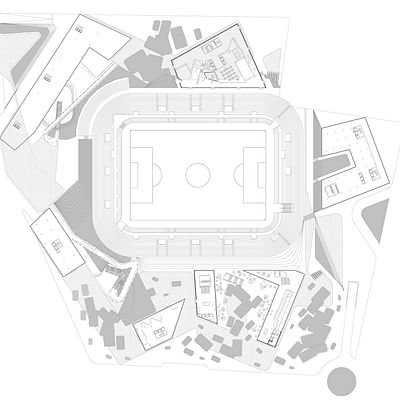Büro Ehring's “hidden stadium” design concept wins Staydium Competition
By Justine Testado|
Wednesday, Jan 29, 2020

Related
The Staydium Competition was based on the all-too-familiar issue of the massive, one-time-use stadiums built for global sporting events like the Olympics that become dilapidated after the Games are long done. Organized by Uni, the ideas competition had entrants design a reusable stadium that can accommodate international events and had to be located in a small city. The stadium had to be able to be converted for a different purpose, like a market, public space, or fitness park, for instance.
NYC-based engineering consultant firm Büro Ehring had the winning submission. They proposed a stadium for the French city of Montpellier by continuing to develop the outskirts of the city, the firm explains. They shared more details about their proposal below.

“With this problem in mind Buro Ehring sought to find an existing solution: The Urban Stadium. For many years, crowded cities with no room for a large venue like a Stadium have been building these sport centers at the core of the city. Although not always successful, the urban stadium solution preemptively counteracts some of the drawbacks to the ‘white elephant’ problem.
Furthermore Buro Ehring's proposal seeks to emphasize the urban context of the stadium, by creating anew over a series of phases a micro-city around the stadium. With region specific programming, and a location that seeks to take advantage of a growing city, the stadium will continuously gain relevance over time.”

“The proposal blends the connection of the stadium to the people of Montpellier not as a symbol, but as an urban catalyst for future development. The Hidden Stadium revolves around a sunken pitch, the stadium itself is invisible, only the act, in this case the memory of the event, is accentuated. In its place however, there will be multiple edifices that are meant to support and create ties with the region of Montpellier.”

“The stadium is composed of five different buildings that surround the pitch. The concept of the stadium plays on the notions of inside/outside, and hide and seek. From the outside, the stadium will appear to be a series of masses overlapping each other. As the visitor gets closer and enters the masses they will be surprised to find a stadium that has been carved out of the ground. The masses on the inside respond to directly to the ‘void’ of the stadium, when the stadium is in use the curved screens that carve the massings will turn on revealing a bowl-like atmosphere hidden behind translucent metal screens.”




Share
0 Comments
Comment as :